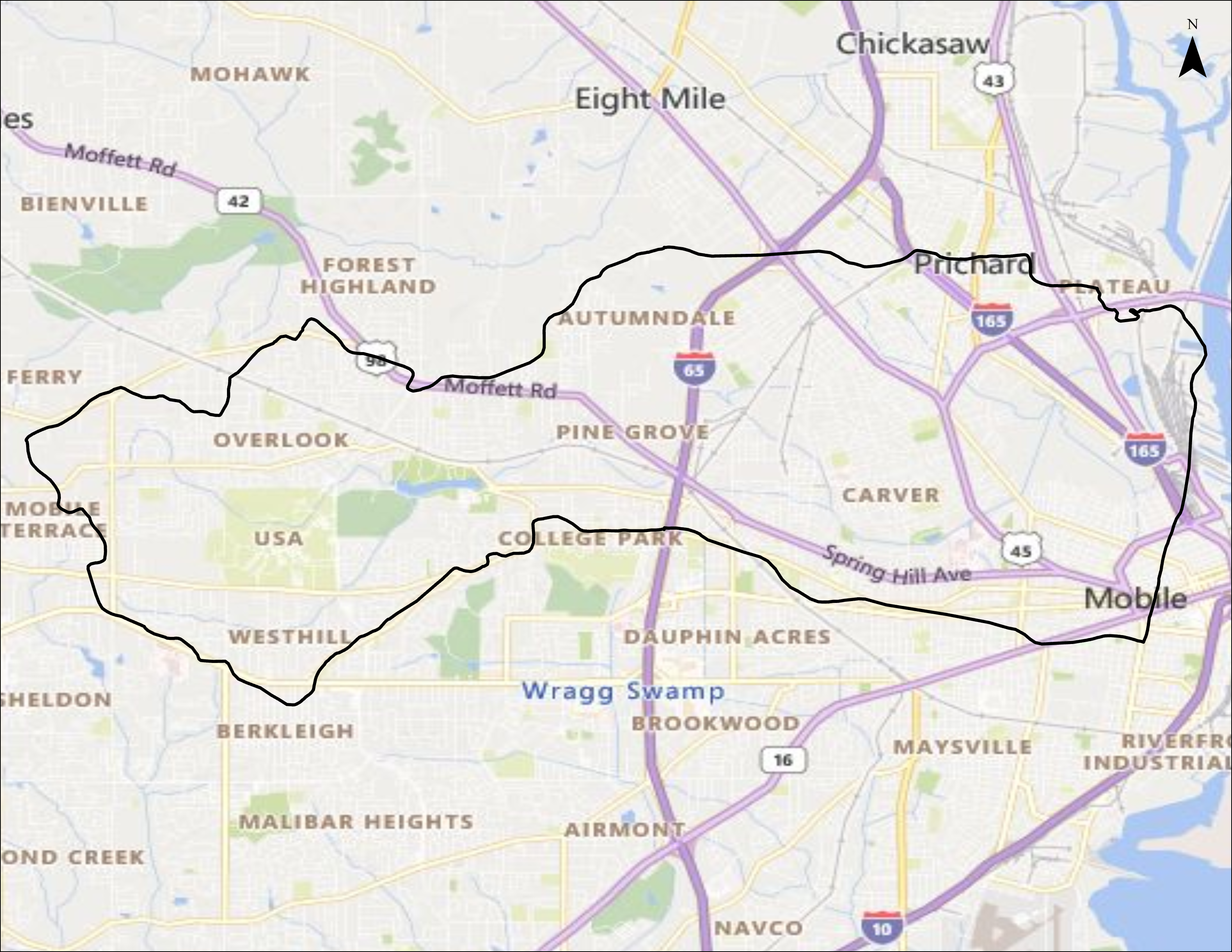The Landscape

Watershed Size and Location
The Three Mile Creek watershed covers over 19,000 acres within the cities Mobile and Prichard. The watershed is almost completely built-out, with residential uses accounting for 42% of the total area, followed by commercial at 26%, transportation at 17% and industrial at 6%. The remaining 9% of the watershed remains undeveloped and is primarily comprised of wetlands.
Main Tributaries and Tidal Influence
Three Mile Creek (HUC 031602040504). Three Mile Creek is fed by three principal tributaries: Twelve Mile Creek, Toulmin Springs Branch, and One Mile Creek. The lower reaches of Three Mile Creek. The upper watershed also contains two notable impoundments, the 62 acre Spring Hill Lake located in Langan Park and a 93-acre wetland system located on the USA campus. The lower reaches of Three Mile Creek, including Toulmins Spring Branch and One Mile Creek are tidally influenced.
Water Use Classification and Impairments
Three Mile Creek is classified by ADEM for Agricultural and Industrial Water Supply usage from its source to the confluence with the Mobile River. Toulmins Spring Branch and Twelve Mile Creek are both classified of Fish and Wildlife. ADEM has developed multiple TMDLs for Three Mile Creek including for Organic Enrichment/low DO for the entire length of TMC. Additionally, TMDLs have been developed for pathogens for the lower reach of Three Mile Creek, Toulmins Spring Branch, and an unnamed tributary that flows through midtown Mobile and joins TMC near the Infirmary Medical Center. A TMDL for organic enrichment for this same unnamed tributary is pending. The primary pollutants of concern affecting water quality are nutrients impacting dissolved oxygen concentrations and pathogens.
Human Uses
The watershed’s location immediately north of the urban core of the city made it one of the very earliest areas impacted by growth, as the population in the early 1700s spread from the French settlements of Old Mobile and Fort Conde that had been established on the shores of the Mobile River. The watershed’s tidal bays and freshwater streams provided a source of food for settlers, and the varied terrain served as convenient homesteading lands. Three Mile Creek also served as Mobile’s source of drinking water until the 1940s. Recreational access is primarily limited to areas surrounding the impoundments on the USA campus and Langan Park as well as Tricentennial Park. Recreational and subsistence fishing occurs along the creek and some limited recreational paddle sports occur in the lower reaches of Three Mile Creek. Lack of recreational access to the creek limits human interaction with the environment and reduces the awareness of the water quality and habitat issues that persist with Three Mile Creek. Physical constraints such as weirs and gabion walls are a deterrent to water sports such as fishing and kayaking establishing further barriers to access.
Ecological Importance
The Three Mile Creek watershed exhibits a diverse and prolific array of flora and fauna. However, the signs of impacts to habitat are evident from anthropogenic activities and population pressures. Wading birds and various hawk species, which are indicators of ample food supply and acceptable habitat are present in Three Mile Creek. Bird species observed in the Three Mile Creek include wading birds and other water-dependent birds, as well as resident raptor and song bird species. The lower reaches of Three Mile Creek provide a unique ecological niche for a population of North America’s largest reptile, the American alligator. Three Mile Creek also serves as the primary location for collecting adult alligator gar for brood fish in an Alabama Dept. of Wildlife and Freshwater Fisheries stock enhancement project.




